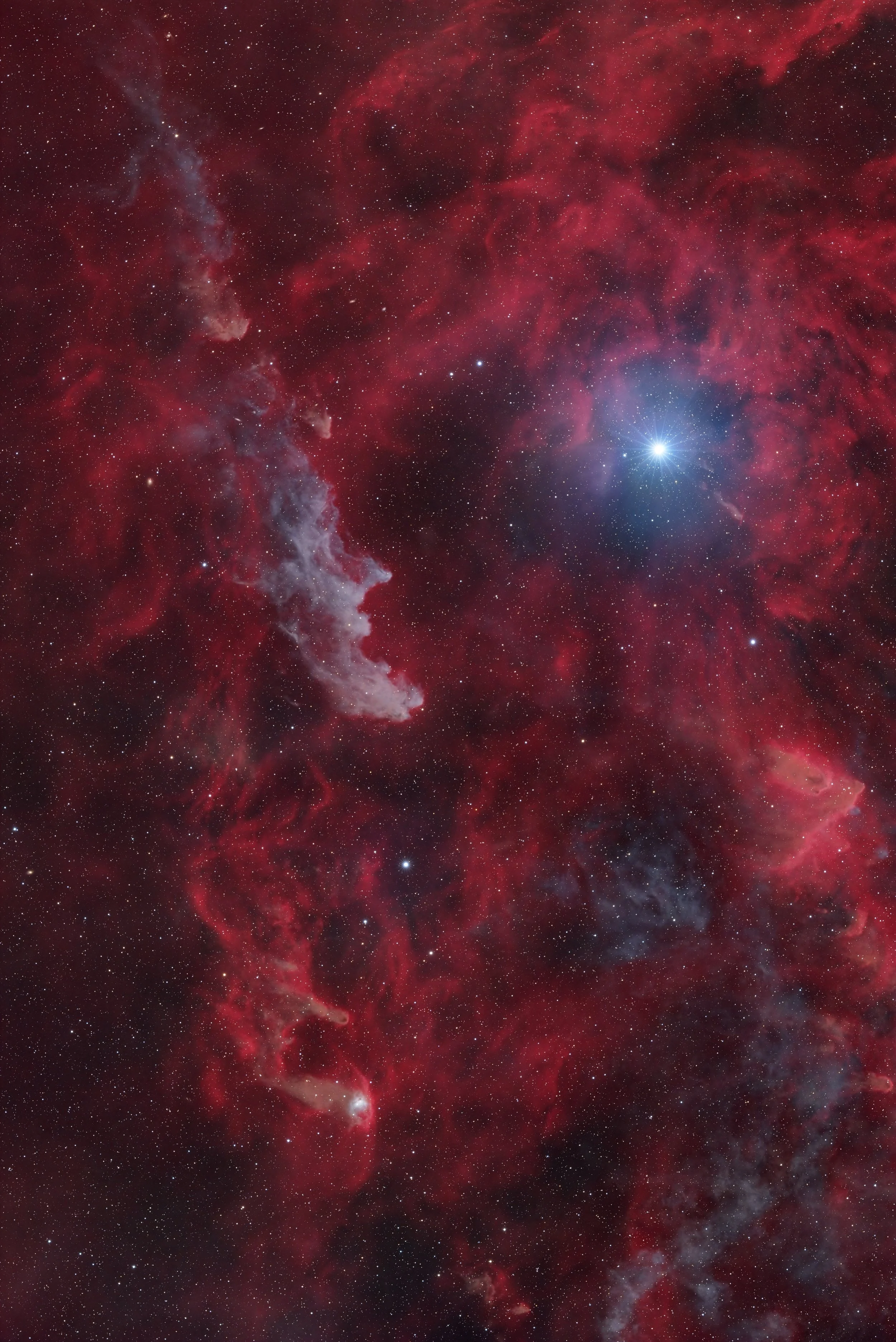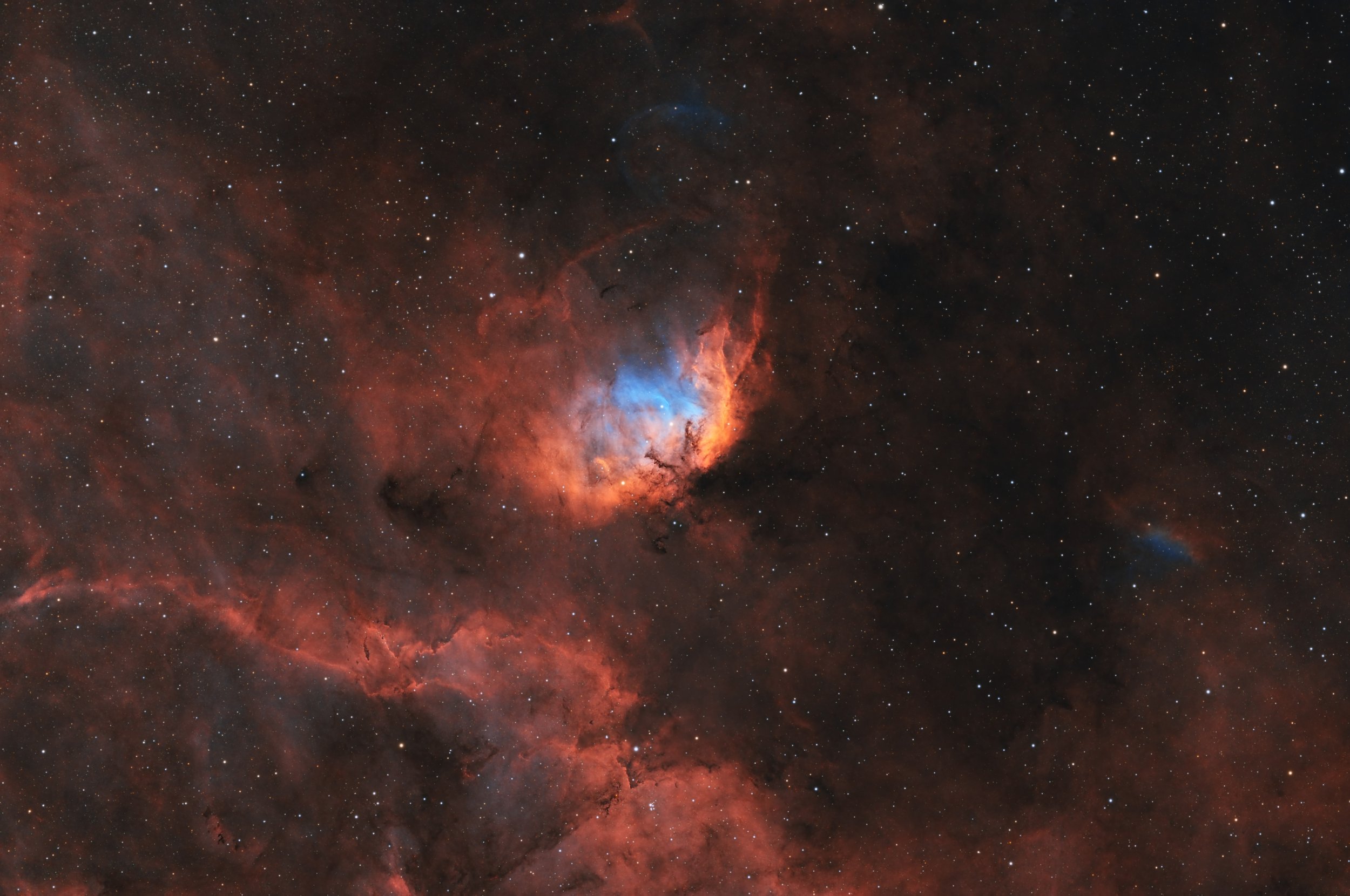
AAPOD2 Image Archives
Rigel to the Witch Head Nebula and more
This wide-field view captures the dazzling blue supergiant star Rigel, the brightest star in Orion, and its spectral neighbor, the Witch Head Nebula (IC 2118). Rigel’s intense ultraviolet light illuminates the Witch Head, creating its ghostly blue glow as it reflects off interstellar dust. The intricate textures of the nebula resemble a witch's profile, adding a mythical touch to this cosmic scene.
Captured from SFRO in Texas, the image reveals the delicate interplay of light and dust stretching across this region of Orion. Surrounding faint nebulosity and subtle interstellar structures add depth to the composition, showcasing the vast, interconnected beauty of this celestial landscape. This dynamic pairing of star and nebula exemplifies the radiant harmony of the Orion region.
Sh2-240 The Spaghetti Nebula
Stretching across the constellation Taurus, Sh2-240, also known as the Spaghetti Nebula, is a breathtaking remnant of a supernova explosion that occurred over 40,000 years ago. Its intricate, filamentary structure weaves a delicate tapestry of gas and dust, glowing faintly as it expands through the void.
The Spaghetti Nebula is a fitting symbol for New Year's Day, representing the passage of time and the interconnected nature of the universe. Its soft, ethereal tendrils remind us that even in the aftermath of explosive endings, beauty and transformation can emerge, weaving together the threads of the past and the promise of the future.
As we gaze at this cosmic masterpiece, it inspires us to reflect on our own journey through time and look forward to the new paths that await in the year ahead.
Comet C/2021 S3 (Panstarrs) in Cygnus
Comet C/2021 S3 (PANSTARRS) is a long-period comet that was discovered by the Pan-STARRS survey on September 27, 2021. The comet's highly elliptical orbit takes it from the distant reaches of the solar system into the inner solar system, where it becomes visible from Earth. As it approaches the Sun, the comet's icy nucleus heats up, causing it to shed gas and dust and form a glowing coma and often a tail that points away from the Sun.
One of the notable features of C/2021 S3 (PANSTARRS) is its brightness, which has allowed for detailed observations and photography by both professional and amateur astronomers. The comet's composition provides insights into the early solar system, as it is made up of primordial materials that have remained largely unchanged since the solar system's formation. Observations of the comet's behavior and its interactions with solar radiation help scientists understand the physical and chemical processes that occur in these distant celestial visitors.
LoTr 5 to NGC 4725 - A Two Panel Mosaic
ourney through the celestial wonders from LoTr 5 to NGC 4725, traversing a vast expanse of the cosmos captured in a captivating two-panel mosaic. Delve into the intricate details of distant galaxies, star clusters, and nebulae that adorn the cosmic landscape.
In this expansive mosaic, LoTr 5 and NGC 4725 emerge as focal points of cosmic beauty. LoTr 5, a lesser-known object, shares its celestial space with NGC 4725, a magnificent spiral galaxy. Each panel reveals a unique glimpse into the mysteries of the universe, inviting viewers to contemplate the vastness and complexity of the cosmos.
LDN 1622 (Bogeyman Nebula) HaLRGB
LDN 1622, famously dubbed the Bogeyman Nebula, presents a captivating celestial spectacle nestled within the constellation Orion. This dark nebula, shrouded in cosmic dust and gas, creates a mysterious and eerie silhouette against the backdrop of the Milky Way. Resembling the mythical figure of the Bogeyman, it evokes a sense of intrigue and wonder among stargazers and astronomers.
Photographed in a combination of hydrogen-alpha (Ha) and RGB filters, this image reveals the intricate details of LDN 1622's structure and surroundings. The HaLRGB composition captures the interplay between light and shadow, showcasing the subtle glow of ionized hydrogen gas amidst the dark tendrils of dust. Such intricate features offer valuable insights into the processes of star formation and interstellar matter within this enigmatic region of space.
Studying LDN 1622 provides astronomers with a window into the complex dynamics of molecular clouds and the birth of new stars. By unraveling the mysteries of this cosmic bogeyman, scientists deepen their understanding of the fundamental processes shaping the evolution of galaxies and the universe at large.
NGC 1491 and PN Ou1
Nestled within the constellation of Perseus, NGC 1491 emerges as a celestial masterpiece, showcasing the intricate beauty of stellar birth and evolution. This emission nebula, illuminated by the energetic radiation of newborn stars, paints a vibrant portrait against the backdrop of the cosmic expanse.
At the heart of NGC 1491 lies a stellar nursery, where dense clouds of gas and dust collapse under their own gravity, giving birth to new generations of stars. The intense ultraviolet radiation emitted by these young stars ionizes the surrounding gas, causing it to glow with ethereal hues of red and blue. NGC 1491 serves as a stellar crucible, where the forces of creation sculpt the cosmic landscape, offering astronomers a window into the dynamic processes shaping our galaxy.
PNOU1: Exploring the Cosmic Mysteries in the Veil Nebula
PNOU1, nestled within the intricate filaments of the Veil Nebula, presents a fascinating glimpse into the aftermath of stellar death. This planetary nebula, born from the remnants of a dying star, showcases the intricate dance of gas and dust as it expands into the surrounding interstellar medium.
As the outer layers of the progenitor star are expelled into space, they form a luminous shell of ionized gas, illuminated by the fading light of the central remnant. PNOU1 represents a fleeting cosmic moment, a testament to the life cycle of stars and the transformative power of stellar winds and supernova explosions. Studying PNOU1 provides astronomers with valuable insights into the final stages of stellar evolution and the complex dynamics of interstellar matter, enriching our understanding of the cosmic tapestry woven across the vastness of space.
SH2-101 Tulip Nebula
In this striking narrowband image captured in the Hubble Palette, Sh2-101, also known as the Tulip Nebula, unveils its cosmic beauty in vivid and ethereal colors. Nestled in the constellation Cygnus and situated approximately 6,000 light-years away from Earth, the Tulip Nebula showcases its intricate structure in a palette that emphasizes specific emissions from hydrogen, sulfur, and oxygen gases.
The image reveals the petals of the Tulip Nebula, with vibrant shades of red, green, and blue, created by the interplay of these elemental gases under the intense radiation of nearby stars. This cosmic scene, presented in the Hubble Palette, serves as a testament to the remarkable beauty and complexity of the universe, where the celestial canvas is painted with the brushstrokes of light, matter, and cosmic forces.
Silver Coin Galaxy
Image Description and Details :
NGC 253 The Sculptor Galaxy. Also known as The Silver Coin or Silver Dollar Galaxy is an intermediate spiral galaxy in the constellation Sculptor. Discovered in 1783 by Caroline Herschel it is one of the brightest galaxies in the night sky. Imaging dates: September 3 to October 3, 2021LRGB - 9 hours 30 minsHa - 4 hoursEquipment list:Takahashi TOA-150 Camera: FLI ML16200Filter: Chroma LRGBSHO 8nmFocuser: FLI AtlasFocal Length: 1100mmFocal Ratio: f/5.0Pixels: 6μmImage Scale: 1.1"Mount: A-P 1600GTO-AELocation: Deep Sky West, Chile
Copyright: Chris Parfett









